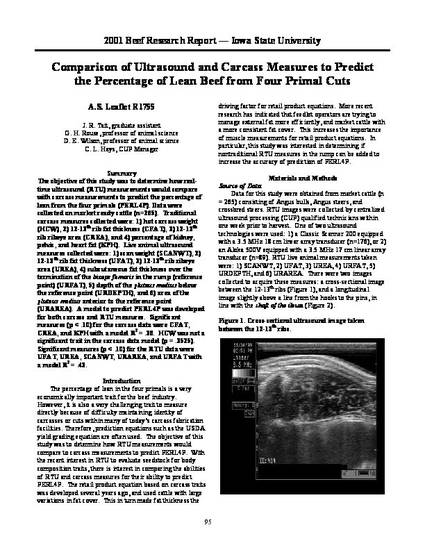
Article
Comparison of Ultrasound and Carcass Measures to Predict the Percentage of Lean Beef from Four Primal Cuts
Beef Research Report, 2001
Extension Number
ASL R1755
Topic
Growth and Development
Publication Date
2002
Disciplines
Abstract
The objective of this study was to determine how realtime ultrasound (RTU) measurements would compare with carcass measurements to predict the percentage of lean from the four primals (PERL4P). Data were collected on market ready cattle (n=265). Traditional carcass measures collected were: 1) hot carcass weight (HCW), 2) 12-13th rib fat thickness (CFAT), 3) 12-13th rib ribeye area (CREA), and 4) percentage of kidney, pelvic, and heart fat (KPH). Live animal ultrasound measures collected were: 1) scan weight (SCANWT), 2) 12-13th rib fat thickness (UFAT), 3) 12-13th rib ribeye area (UREA), 4) subcutaneous fat thickness over the termination of the biceps femoris in the rump (reference point) (URFAT), 5) depth of the gluteus medius below the reference point (URDEPTH), and 6) area of the gluteus medius anterior to the reference point (URAREA). A model to predict PERL4P was developed for both carcass and RTU measures. Significant measures (p < .10) for the carcass data were CFAT, CREA, and KPH with a model R2 = .38. HCW was not a significant trait in the carcass data model (p = .3525). Significant measures (p < .10) for the RTU data were UFAT, UREA, SCANWT, URAREA, and URFAT with a model R2 = .43.
Copyright Owner
Iowa State University
Copyright Date
2002
Language
en
File Format
PDF
Citation Information
Richard G. Tait, Gene H. Rouse, Doyle E. Wilson and Craig L. Hays. "Comparison of Ultrasound and Carcass Measures to Predict the Percentage of Lean Beef from Four Primal Cuts" (2002) Available at: http://works.bepress.com/rich_tait_jr/1/
